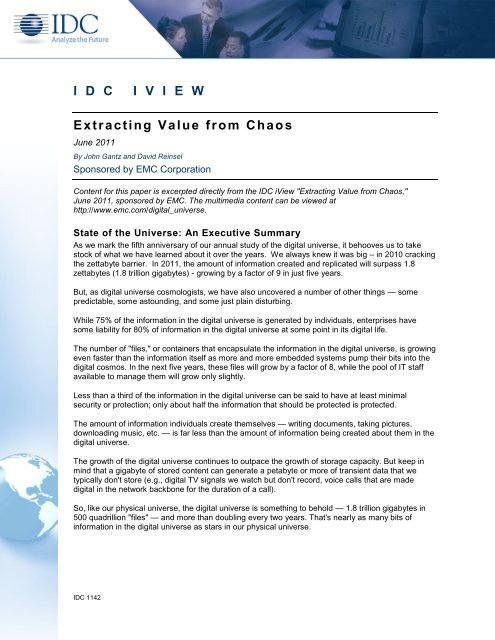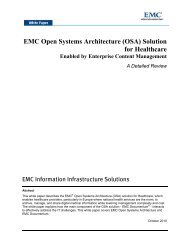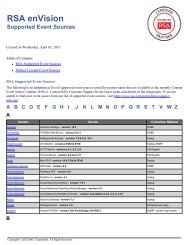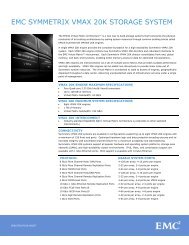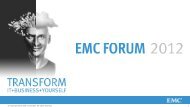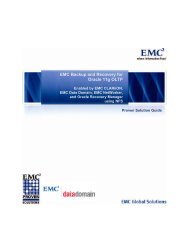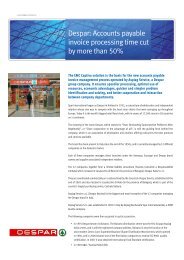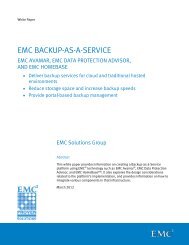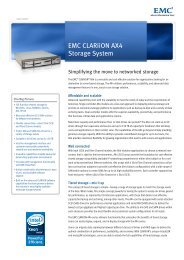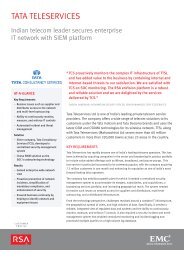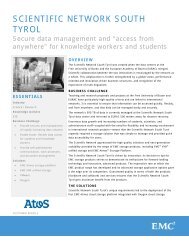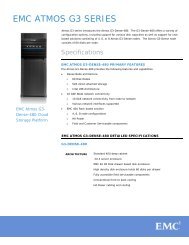Extracting Value from Chaos - EMC
Extracting Value from Chaos - EMC
Extracting Value from Chaos - EMC
You also want an ePaper? Increase the reach of your titles
YUMPU automatically turns print PDFs into web optimized ePapers that Google loves.
I D C I V I E W<br />
E x t r a c t i n g <strong>Value</strong> <strong>from</strong> <strong>Chaos</strong><br />
June 2011<br />
By John Gantz and David Reinsel<br />
Sponsored by <strong>EMC</strong> Corporation<br />
Content for this paper is excerpted directly <strong>from</strong> the IDC iView "<strong>Extracting</strong> <strong>Value</strong> <strong>from</strong> <strong>Chaos</strong>,"<br />
June 2011, sponsored by <strong>EMC</strong>. The multimedia content can be viewed at<br />
http://www.emc.com/digital_universe.<br />
State of the Universe: An Executive Summary<br />
As we mark the fifth anniversary of our annual study of the digital universe, it behooves us to take<br />
stock of what we have learned about it over the years. We always knew it was big – in 2010 cracking<br />
the zettabyte barrier. In 2011, the amount of information created and replicated will surpass 1.8<br />
zettabytes (1.8 trillion gigabytes) - growing by a factor of 9 in just five years.<br />
But, as digital universe cosmologists, we have also uncovered a number of other things — some<br />
predictable, some astounding, and some just plain disturbing.<br />
While 75% of the information in the digital universe is generated by individuals, enterprises have<br />
some liability for 80% of information in the digital universe at some point in its digital life.<br />
The number of "files," or containers that encapsulate the information in the digital universe, is growing<br />
even faster than the information itself as more and more embedded systems pump their bits into the<br />
digital cosmos. In the next five years, these files will grow by a factor of 8, while the pool of IT staff<br />
available to manage them will grow only slightly.<br />
Less than a third of the information in the digital universe can be said to have at least minimal<br />
security or protection; only about half the information that should be protected is protected.<br />
The amount of information individuals create themselves — writing documents, taking pictures,<br />
downloading music, etc. — is far less than the amount of information being created about them in the<br />
digital universe.<br />
The growth of the digital universe continues to outpace the growth of storage capacity. But keep in<br />
mind that a gigabyte of stored content can generate a petabyte or more of transient data that we<br />
typically don't store (e.g., digital TV signals we watch but don't record, voice calls that are made<br />
digital in the network backbone for the duration of a call).<br />
So, like our physical universe, the digital universe is something to behold — 1.8 trillion gigabytes in<br />
500 quadrillion "files" — and more than doubling every two years. That's nearly as many bits of<br />
information in the digital universe as stars in our physical universe.<br />
IDC 1142
However, unlike our physical universe where matter is neither created nor destroyed, our digital<br />
universe is replete with bits of data that exist but for a moment — enough time for our eyes or ears to<br />
ingest the information before the bits evaporate into a nonexistent digital dump.<br />
This is not to diminish the value of the temporary existence of these bits that can serve a variety of<br />
purposes during their short lives, such as driving consumption (to increase ad revenue <strong>from</strong> Web site<br />
traffic) or real-time data analytics (to optimize existing operations and create entirely new markets).<br />
What are the forces behind the explosive growth of the digital universe? Certainly technology has<br />
helped by driving the cost of creating, capturing, managing, and storing information down to one-sixth<br />
of what it was in 2005. But the prime mover is financial. Since 2005, the investment by enterprises in<br />
the digital universe has increased 50% — to $4 trillion. That's money spent on hardware, software,<br />
services, and staff to create, manage, and store — and derive revenues <strong>from</strong> — the digital universe.<br />
In an information society, information is money. The trick is to generate value by extracting the right<br />
information <strong>from</strong> the digital universe — which, at the microcosmic level familiar to the average CIO,<br />
can seem as turbulent and unpredictable as the physical universe.<br />
In fact, thanks to new tools and technologies, and new IT and organizational practices, we may be on<br />
the threshold of a major period of exploration of the digital universe. The convergence of technologies<br />
now makes it possible not only to transform the way business is conducted and managed but also to<br />
alter the way we work and live.<br />
Considerations<br />
New capture, search, discovery, and analysis tools can help organizations gain insights <strong>from</strong> their<br />
unstructured data, which accounts for more than 90% of the digital universe. These tools can create<br />
data about data automatically, much like facial recognition routines that help tag Facebook photos.<br />
Data about data, or metadata, is growing twice as fast as the digital universe as a whole.<br />
Business intelligence tools increasingly are dealing with real-time data, whether it's charging auto<br />
insurance premiums based on where people drive, routing power through the intelligent grid, or<br />
changing marketing messages on the fly based on social networking responses.<br />
New storage management tools are available to cut the costs of the part of the digital universe we<br />
store, such as deduplication, auto-tiering, and virtualization, as well as to help us decide what exactly<br />
to store, as in content management solutions.<br />
An entire industry has grown up to help us follow the rules (laws, regulations, and customs) pertaining<br />
to information in the enterprise. It is now possible to get regulatory compliance systems built into<br />
storage management systems.<br />
New security practices and tools can help enterprises identify the information that needs to be<br />
secured and at what level of security and then secure the information using specific threat protection<br />
devices and software, fraud management systems, or reputation protection services.<br />
Cloud computing solutions — both public and private and a combination of the two known as hybrid<br />
— provide enterprises with new levels of economies of scale, agility, and flexibility compared with<br />
traditional IT environments. In the long term, this will be a key tool for dealing with the complexity of<br />
the digital universe (see Figure 1).<br />
Cloud computing is enabling the consumption of IT as a service. Couple that with the "big data"<br />
phenomenon, and organizations increasingly will be motivated to consume IT as an external service<br />
versus internal infrastructure investments.<br />
2<br />
©2011 IDC
F i g u r e 1<br />
A Decade of Digital Universe Growth: Storage in Exabytes<br />
Source: IDC's Digital Universe Study, sponsored by <strong>EMC</strong>, June 2011<br />
This period of "space exploration" of the digital universe will not be without its challenges. But for the<br />
"astronauts" involved — CIOs and their staff—– it represents a unique, perhaps once-in-a-career<br />
opportunity to drive growth for their enterprises. They will need to lead the enterprise in the adoption<br />
of new information-taming technologies, best practices for leveraging and extracting value <strong>from</strong> data,<br />
and the creation of new roles and organizational design. Each step will require organizational change,<br />
not just a few new computers or more software. The success of many enterprises in the coming years<br />
will be determined by how successful CIOs are in driving the required enterprisewide adjustment to<br />
the new realities of the digital universe (see Figure 2).<br />
©2011 IDC 3
F i g u r e 2<br />
The Digital Universe Growth Paradox: Falling Cost and Rising Investment<br />
Source: IDC's Digital Universe Study, sponsored by <strong>EMC</strong>, June 2011<br />
Journey to the Cloud<br />
As the digital universe expands and gets more complex, processing, storing, managing, securing,<br />
and disposing of the information in it become more complex as well.<br />
Consider this: Over the next decade, the number of servers (virtual and physical) worldwide will grow<br />
by a factor of 10, the amount of information managed by enterprise datacenters will grow by a factor<br />
of 50, and the number of files the datacenter will have to deal with will grow by a factor of 75, at least.<br />
Meanwhile, the number of IT professionals in the world will grow by less than a factor of 1.5.<br />
As a result, the skills, experience, and resources to manage all these bits of data will become scarcer<br />
and more specialized, requiring a new, flexible, and scalable IT infrastructure, extending beyond the<br />
enterprise. Today we call it cloud computing.<br />
And while cloud computing accounts for less than 2% of IT spending today, IDC estimates that by 2015<br />
nearly 20% of the information will be "touched" by cloud computing service providers — meaning that<br />
somewhere in a byte's journey <strong>from</strong> originator to disposal it will be stored or processed in a cloud.<br />
Perhaps as much as 10% will be maintained in a cloud.<br />
Much of the current movement to cloud architectures is being enabled by pervasive adoption of<br />
virtualization. Last year was the first year in which more virtual servers were shipped than physical<br />
servers. IDC estimates that today nearly 10% of the information running through servers is doing so<br />
on virtualized systems and expects that number to grow to more than 20% in 2015. This percentage<br />
increases along with the size of the organization. Some larger environments today operate with 100%<br />
virtualized systems.<br />
4<br />
©2011 IDC
Of course, cloud services come in various flavors — public, private, and hybrid. For organizations to<br />
offer their own cloud services, they have to do more than just run virtual servers. They must also<br />
allow for virtualized storage and networking, self-provisioning, and self-service — and provide<br />
information security and billing. Few enterprises are here yet, so the impact of private clouds on the<br />
digital universe today is small (see Figure 3). But by 2015, when the virtualized infrastructure is more<br />
common, the rate of growth will accelerate.<br />
F i g u r e 3<br />
The Digital Universe and the Public Cloud, 2015<br />
Source: IDC's Digital Universe Study, sponsored by <strong>EMC</strong>, June 2011<br />
The challenges for cloud adoption include:<br />
� Data preparation for conversion to cloud<br />
� Integrated cloud/noncloud management<br />
� Service-level agreements and termination strategies<br />
� Security, backup, archiving, and disaster control strategies<br />
� Intercountry data transfer and compliance<br />
� Organizational politics<br />
The latter is nontrivial. Many of the most successful virtualization projects succeed, in part, because<br />
CIOs have developed opt-in and opt-out strategies for internal departments that may be reluctant to<br />
share responsibility for what was once considered "their" information or data. Converting to cloud<br />
computing means changing the status quo — always a difficult task, even if there are good reasons<br />
to do so.<br />
©2011 IDC 5
Big <strong>Value</strong> <strong>from</strong> Big Data<br />
Big data is a big dynamic that seemed to appear <strong>from</strong> nowhere. But in reality, big data isn't new.<br />
Instead, it is something that is moving into the mainstream and getting big attention, and for good<br />
reason. Big data is being enabled by inexpensive storage, a proliferation of sensor and data capture<br />
technology, increasing connections to information via the cloud and virtualized storage<br />
infrastructures, and innovative software and analysis tools. Big data is not a "thing" but instead a<br />
dynamic/activity that crosses many IT borders. IDC defines it this way:<br />
Big data technologies describe a new generation of technologies and<br />
architectures, designed to economically extract value <strong>from</strong> very large volumes<br />
of a wide variety of data, by enabling high-velocity capture, discovery, and/or<br />
analysis.<br />
Big data is a horizontal cross-section of the digital universe and can include transactional data,<br />
warehoused data, metadata, and other data residing in ridiculously large files. Media/entertainment,<br />
healthcare, and video surveillance are obvious examples of new segments of big data growth. Social<br />
media solutions such as Facebook, Foursquare, and Twitter are the newest new data sources.<br />
Essentially, they have built systems where consumers (consciously or unconsciously) are providing<br />
near continuous streams of data about themselves, and thanks to the "network effect" of successful<br />
sites, the total data generated can expand at rapid logarithmic rates.<br />
It is important to understand that big data is not only about the original content stored or being<br />
consumed but also about the information around its consumption. Smartphones are a great<br />
illustration of how our mobile devices produce additional data sources that are being captured and<br />
that include geographic location, text messages, browsing history, and (thanks to the addition of<br />
accelerometers and GPS) even motion or direction (see Figure 4).<br />
6<br />
©2011 IDC
F i g u r e 4<br />
Big Data Is Not the Created Content, nor Is It Even Its Consumption — It Is the Analysis of<br />
All the Data Surrounding or Swirling Around It<br />
Source: IDC's Digital Universe Study, sponsored by <strong>EMC</strong>, June 2011<br />
Capture and analysis of this "swirling vortex" of data is a definite big data opportunity but also a<br />
source of consternation for datacenter managers. Datacenter architectures and organizational<br />
models will need to evolve as big data applications pervade a company's infrastructure. The IT<br />
architectural and organizational approach used in clustered environments like a large Hadoop grid is<br />
radically different <strong>from</strong> the converged and virtualized IT environments driving most organizations'<br />
datacenter transformation strategies.<br />
Big data will inject high-velocity requirements associated with capture and analysis, as well as<br />
results/predictive reporting. With big data, IT is best organized around the specific opportunity and/or<br />
capability rather than merely a set of shared services that serve both traditional and newer uses.<br />
Most IT disciplines — <strong>from</strong> infrastructure to applications to governance — are ideally part of a single<br />
integrated team and work closely with users of big data in ways that are very distinct <strong>from</strong> traditional<br />
enterprise IT approaches.<br />
The cloud providers will play a key enabling role in nearly every facet of the big data space. First,<br />
they will be among the most important collectors of data streams and content. Second, they will be<br />
among the most aggressive users of big data systems to run their own businesses. Third, they will<br />
also be in a position to enable big data use by technically savvy, but resource constrained,<br />
organizations (through simple, temporary provisioning of large compute and data pools). For<br />
example, cloud-based big data platforms will make it practical for smaller engineering and<br />
architectural firms to access massive compute resources for short, semipredictable time periods<br />
without having to build their own big data farms.<br />
©2011 IDC 7
The ultimate value of a big data implementation will be judged based on one or more of three criteria:<br />
� Does it provide more useful information?<br />
� Does it improve the fidelity of the information?<br />
� Does it improve the timeliness of the response?<br />
Netflix suggesting your next movie rental, dynamic monitoring of embedded sensors in bridges to<br />
detect real-time stresses and longer-term erosion, and retailers analyzing digital video streams to<br />
optimize product and display layouts and promotional spaces on a store-by-store basis are a few real<br />
examples of how big data is involved in our lives today.<br />
Big data represents both big opportunities and big challenges for CIOs. Almost every CIO aspires to<br />
make IT a more valued asset to the organization. And IT is front and center in big data projects,<br />
which are typically at the boundaries of the business where many of the most significant business<br />
expansion or cost reduction opportunities lie.<br />
Big data also poses a number of challenges. As noted earlier, big data buildouts can be disruptive to<br />
current datacenter transformation plans. In addition, big data deployments require new IT administration<br />
and application developer skill sets. People with these skills are likely to be in short supply for quite a<br />
while. The biggest challenge, however, is the cultural challenge. Today, many of these big data projects<br />
are best described as "junior science projects" with a small core of servers and storage assets.<br />
However, unless managed closely, these small projects can quickly turn into the next "Manhattan<br />
project" with companywide and industrywide business, organizational, and legal consequences.<br />
Challenges aside, the opportunities abound. Taking a lead in big data efforts provides the CIO with<br />
an opportunity to be the most significant strategic partner for a business unit or even drive a<br />
transformation of the entire enterprise.<br />
Trust in the Digital Universe<br />
Last year, for the first time, we sized the amount of information in the digital universe that requires<br />
some level of security. The frightening realization is that the amount of information that needs to be<br />
secured is growing faster than our ability to secure it as employees leverage more mobile devices,<br />
consumers knowingly (and unknowingly) share more personal data, and companies find new ways to<br />
mine this data.<br />
For the sake of understanding the degree of security in the digital universe, we have classified<br />
information that requires security into five categories, each requiring successively higher levels:<br />
� Privacy only — such as an email address on a YouTube upload<br />
� Compliance driven — such as emails that might be discoverable in litigation or subject to<br />
retention rules<br />
� Custodial — account information, a breach of which could lead to or aid in identity theft<br />
� Confidential — information the originator wants to protect, such as trade secrets, customer lists,<br />
confidential memos, etc.<br />
� Lockdown — information requiring the highest security, such as financial transactions, personnel<br />
files, medical records, military intelligence, etc.<br />
In 2010, 28% of the digital universe required some level of security (see Figure 5). Note that this is<br />
information that needs security. It may not have it.<br />
8<br />
©2011 IDC
F i g u r e 5<br />
The Need for Information Security: Percentage of the Digital Universe<br />
Source: IDC's Digital Universe Study, sponsored by <strong>EMC</strong>, June 2011<br />
The growing amount of information that requires security is driven largely <strong>from</strong> two main sources:<br />
corporations (including employees) and consumers. Compounding this are government regulations<br />
and company policies and processes that mandate the capture and preservation of various data.<br />
More organizations are adopting policies where users have control over the laptops, tablets, and<br />
smartphones that they could use to conduct their business (or personal) affairs. Given that IT<br />
resources increasingly are drawn <strong>from</strong> a combination of private and public infrastructures, the<br />
pressure is on for these organizations to figure out a way to manage security and compliance<br />
obligations across multiple many-to-many relationships.<br />
The notion of trust in how information is used, shared, archived, and managed is critical in this<br />
complex and highly fluid environment. Trust relates to the origin of the information; the integrity of the<br />
processes and the computing systems that generate, capture, and manage the information; as well<br />
as the credentials and identities of the individuals and business entities that touch or have access to<br />
the information.<br />
We are seeing this discussion around trust unfolding before us today. Online data collection is<br />
becoming more invasive, data mining analytics and big data make it possible for businesses to profile<br />
individual consumers, and individuals are expanding their digital shadow through their use of mobile<br />
device applications and their participation in social networking sites. As a result, there are increasing<br />
calls <strong>from</strong> advocates, academics, and regulators to amend the current privacy and data protection<br />
regimes.<br />
A few years ago, we introduced the concept of the digital shadow (see Figure 6). This shadow is<br />
growing faster every year, and most of the time without our knowing it. Our digital shadow is made up<br />
of information we may deem public but also data that we would prefer to remain private. Yet, it is<br />
within this growing mist of data where big data opportunities lie — to help drive more personalized<br />
©2011 IDC 9
services, manage connectivity more efficiently, or create new businesses based on valuable, yet-tobe-discovered<br />
intersections of data among groups or masses of people.<br />
F i g u r e 6<br />
Fueling the Digital Universe: The Digital Shadow<br />
Source: IDC's Digital Universe Study, sponsored by <strong>EMC</strong>, June 2011<br />
Organizations that manage their own private cloud, or those that provide public cloud services, must<br />
find ways to mitigate unnecessary or accidental exposure of secure information. Employees and<br />
consumers (individuals) cannot be trusted to do the right thing all the time. Instead, organizations must<br />
integrate policies and processes to create an environment of trust that is automated and thorough and<br />
not sustained by siloed and manual operations. The following specific steps are needed:<br />
� Enterprises must understand the dependencies across processes and compute resources.<br />
� Enterprises need to be able to identify potential policy conflicts, as well as analyze the impact of<br />
new technologies and processes on their overall risk and compliance posture.<br />
� With IT organizations managing very complex network topologies and vendor relationships, they<br />
need to be able to correlate dependencies across events and changes to configuration standards<br />
across functional systems. Further, they need to be able to track dependencies across people,<br />
processes, information, and the underlying compute resources.<br />
� Enterprises have to be able to demonstrate that they are consistently meeting their regulatory<br />
and legal obligations.<br />
10<br />
©2011 IDC
The convergence of these developments — mobile computing, consumerization of IT, cloud<br />
computing, big data, and advanced data mining technologies — is compelling many organizations to<br />
transition <strong>from</strong> a "chasing compliance" mindset to a risk management mindset. A risk management<br />
framework would allow an organization to tailor its responses to the criticality of the information,<br />
business process, and business relationships. Because resources are limited, a programmatic risk<br />
management framework also allows an organization to prioritize its resources so that it is able to<br />
identify and respond more quickly to the most critical threats to its security and compliance postures.<br />
Call to Action<br />
Since 2007, IDC's Digital Universe Study has highlighted the mismatch between the rapid growth of<br />
the digital universe and the very slow growth of staff and investment to manage it. This year, the<br />
study highlights an additional issue that promises to define for CIOs and business executives much of<br />
the next 10 years of their careers: the mismatch between the value of some data and the value of<br />
other data. In the digital universe, it is now possible to run factories <strong>from</strong> afar, tap vast stores of social<br />
networking traffic for meaning, analyze customers in efficient ways that were impossible even a few<br />
years ago, and create smart cities, buildings, and homes. But this requires sifting through the data<br />
molecules (while they exist) in the digital universe to identify the ones that matter and creating<br />
organizational value out of them.<br />
And there's the rub. CIOs and their staff may be able to manage the new tools of search and<br />
discovery, information classification and management, information security, and even information<br />
disposal, but organizations have to be prepped and ready to deal with the nuggets that can now be<br />
pulled out of the digital universe.<br />
So the call to action <strong>from</strong> this year's study has two components — one technical, one organizational.<br />
The technical calls to action are:<br />
� Investigate the new tools for creating metadata — the information you will need to understand<br />
which data is needed when and for what. Big data will be a fountain of big value only if it can<br />
speak to you through metadata.<br />
� Master virtualization, not just server and storage virtualization but also application virtualization.<br />
Start working on self-provisioning and self-service, including metering and billing.<br />
� Move what you can to the cloud — it's inevitable. But it will require a new level of commitment<br />
and rigor toward managing the process. It's more than simply an outsourcing contract.<br />
� Determine which big data projects will have the most "bang," along with the requisite data sets<br />
and analytical tools. From there, formulate an enterprise data strategy that overcomes legacy<br />
data integration limitations and layers in the new required tools and techniques.<br />
� Stay very close to the latest information security strategies and practices.<br />
� Be aggressive in developing and managing advanced storage management tools.<br />
The organizational calls to action are:<br />
� Set the strategy and build, with other C-level executives, a process for migrating to shared<br />
resources — virtualization today, public and private clouds tomorrow. This will take leadership,<br />
coercion, cajoling, and politicking.<br />
� Begin laying the organizational groundwork today with the specific analytical and managerial skill<br />
sets, mindsets, and processes necessary to extract the most value possible <strong>from</strong> big data.<br />
©2011 IDC 11
� Work to make your company a data-driven organization. New tools — <strong>from</strong> smartphones and<br />
iPads to executive dashboards and real-time business intelligence — can make this easier, but<br />
the blessings of the digital universe will be lost on the organization that won't take action based<br />
on what the data tells it. If you don't, you can be sure that the competition will.<br />
� Press your suppliers and business partners to help. We are still coming out of a global recession,<br />
but we are 10 years into a technology renaissance. Companies that aren't at least fast followers<br />
of those pushing the envelope of data and information utilization and management will simply fall<br />
behind.<br />
The combination of post-recession business growth, a technology renaissance, and the growth of the<br />
digital universe this next decade creates a once-in-a-career opportunity for CIOs and their staff to<br />
drive change and growth for their organizations. The growth of the digital universe may be a<br />
challenge, but it is also a propellant for new and exciting uses of data.<br />
A B O U T T H I S P U B L I C A T I ON<br />
This publication was produced by IDC Go-to-Market Services. The opinion, analysis, and research results presented herein<br />
are drawn <strong>from</strong> more detailed research and analysis independently conducted and published by IDC, unless specific vendor<br />
sponsorship is noted. IDC Go-to-Market Services makes IDC content available in a wide range of formats for distribution by<br />
various companies. A license to distribute IDC content does not imply endorsement of or opinion about the licensee.<br />
C O P Y R I G H T A N D R E S T R I C T I O N S<br />
Any IDC information or reference to IDC that is to be used in advertising, press releases, or promotional materials requires<br />
prior written approval <strong>from</strong> IDC. For permission requests, contact the GMS information line at 508-988-7610 or gms@idc.com.<br />
Translation and/or localization of this document requires an additional license <strong>from</strong> IDC.<br />
For more information on IDC, visit www.idc.com. For more information on IDC GMS, visit www.idc.com/gms.<br />
Global Headquarters: 5 Speen Street Framingham, MA 01701 USA P.508.872.8200 F.508.935.4015 www.idc.com<br />
12<br />
©2011 IDC


